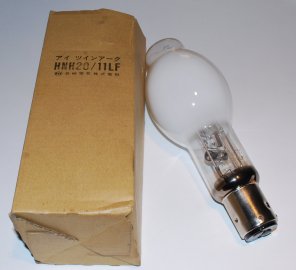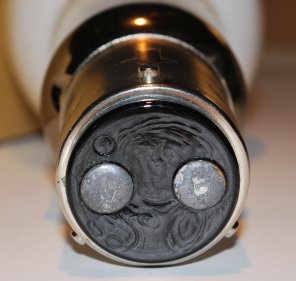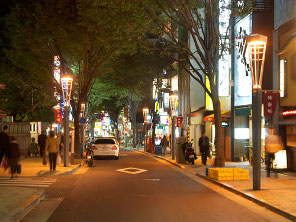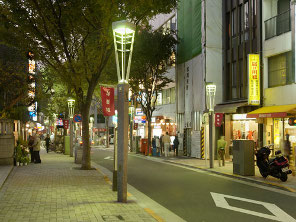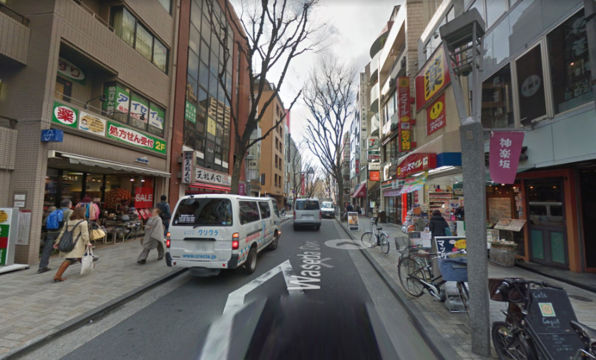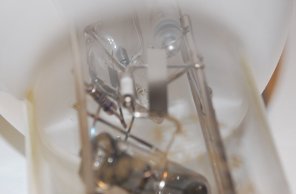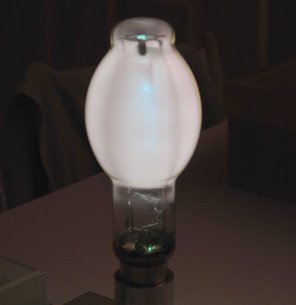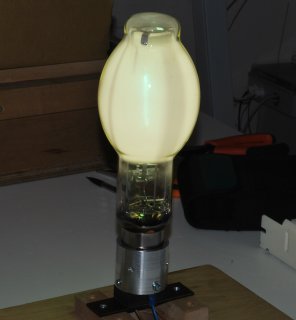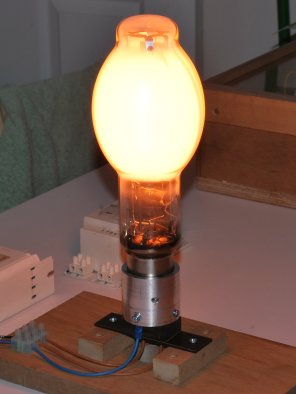Last change: September 03 2019
EYE Twinarc HNH 20/11LF
Click pictures for bigger version.
This is a very unusual lamp, made by Iwasaki and branded 'Eye'. As far
as I can find out, intended for the Japanese market only. It has 2 arc
tubes- a HPS and a mercury in a BT-28 envelope, capable of being lit
separately as the base has 3 connections- 2 on the bottom and the
collar. Iwasaki describe it as a B40d-45. It's the same diameter as a
mogul (GES) screw base.
On the package the katakana at the top phonetically spells:
"Eye Twinarc"
アイツインアーク (Ai Tuināku)
Below the model code is written:
岩崎電気株式会社 (Iwasakidenki kabushikigaisha)
Iwasaki Electric Co., Ltd.
A look on the Eye Lighting Japanese website reveals these lamps to be used in special roadway and flood lighting luminaires, with the light colour being changed to match the season- warm HPS in Winter, and cool mercury light in Summer. It also showed the retail price- ¥20,790 which at May 2009 exchange rates was £140 per lamp.
A look at the 2017-18 Eye Lighting catalogue for the Japanese market shows that these lamps are still listed, albeit as made-to-order items. The ballasts (choke-type for 200V input), part# TH20/11C2A42 are also still listed, again as made-to-order. The fixtures in the GSV image below seem to have been discontinued though. They do still list one fixture, the H6003, that will take these lamps. The case studies and reference sites- 4 of them- are still present on the Eye lighting website.
However, despite the continuing widespread use in Japan of mercury lamps, their life is limited now by legislation. This is a worldwide trend, not limited to Japan. For instance the US EPACT legislation of 2005 restricted mercury lamp usage there on the basis of energy consumption. There is now the Minamata Convention on Mercury which is a UN treaty to limit worldwide mercury pollution, named after the Japanese city where a widespread and devastating mercury poisoning incident occurred in the 20th century. The convention was made in 2013, and officially adopted by Japan in 2016. Japan is implementing it in relation to mercury lamps as follows:
On the package the katakana at the top phonetically spells:
"Eye Twinarc"
アイツインアーク (Ai Tuināku)
Below the model code is written:
岩崎電気株式会社 (Iwasakidenki kabushikigaisha)
Iwasaki Electric Co., Ltd.
A look on the Eye Lighting Japanese website reveals these lamps to be used in special roadway and flood lighting luminaires, with the light colour being changed to match the season- warm HPS in Winter, and cool mercury light in Summer. It also showed the retail price- ¥20,790 which at May 2009 exchange rates was £140 per lamp.
Update Sep 2017/Jun 2019
Sightings on various NHK World TV programmes over the past few months reveal the location of the reference site that is shown on the Eye Lighting website- and that these special fixtures are still in place some time into 2018 (it is possible though that they have been retrofitted with LED as all the views I saw were in daytime). A look at GSV shows they are to be found on Waseda Dori in the Kagurazaka district (Shinjuku ward) of Tokyo.A look at the 2017-18 Eye Lighting catalogue for the Japanese market shows that these lamps are still listed, albeit as made-to-order items. The ballasts (choke-type for 200V input), part# TH20/11C2A42 are also still listed, again as made-to-order. The fixtures in the GSV image below seem to have been discontinued though. They do still list one fixture, the H6003, that will take these lamps. The case studies and reference sites- 4 of them- are still present on the Eye lighting website.
However, despite the continuing widespread use in Japan of mercury lamps, their life is limited now by legislation. This is a worldwide trend, not limited to Japan. For instance the US EPACT legislation of 2005 restricted mercury lamp usage there on the basis of energy consumption. There is now the Minamata Convention on Mercury which is a UN treaty to limit worldwide mercury pollution, named after the Japanese city where a widespread and devastating mercury poisoning incident occurred in the 20th century. The convention was made in 2013, and officially adopted by Japan in 2016. Japan is implementing it in relation to mercury lamps as follows:
- Manufacture, export and import of high pressure mercury lamp for general lighting are prohibited after 2021
- Metal halide lamp · High pressure sodium lamp is not subject to regulation
- Lamps for special purpose other than general lighting such as ultraviolet lamp are not subject to regulation
- Fluorescent lamps regulate the amount of mercury enclosed (5-10 mg)
Lamp Details
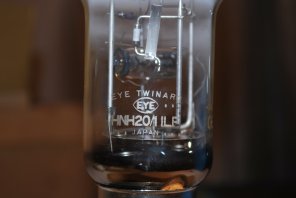
The envelope is phosphored, so it's difficult to see the internal construction- you can just about see the ends of the mercury arc tube and starting resistor on the left, if you look at the closeup of the etch you can see the glowbottle starter for the HPS arc tube also.
As can be seen from the designation the mercury arc tube is rated at 200W, the HPS at 110W- neither rating common outside Japan. From the lamp data, they both produce 9000lm, and can be run here in the UK quite easily. The HPS arc tube is rated at 115V/1.15A so is a retrofit for a UK 125W mercury lamp, it doesn't need a starter either so can be run from 240V on a simple choke ballast. The 200W mercury arc tube is rated at 120V/1.9A and can be run on a UK 150W HPS ballast which overruns it slightly in practise.
Looking at the etch, just out of shot is the mark '04L' which I assume means Nov 2004, also there is a CE mark so maybe these lamps are intended for sale outside of Japan after all.
As can be seen from the designation the mercury arc tube is rated at 200W, the HPS at 110W- neither rating common outside Japan. From the lamp data, they both produce 9000lm, and can be run here in the UK quite easily. The HPS arc tube is rated at 115V/1.15A so is a retrofit for a UK 125W mercury lamp, it doesn't need a starter either so can be run from 240V on a simple choke ballast. The 200W mercury arc tube is rated at 120V/1.9A and can be run on a UK 150W HPS ballast which overruns it slightly in practise.
Looking at the etch, just out of shot is the mark '04L' which I assume means Nov 2004, also there is a CE mark so maybe these lamps are intended for sale outside of Japan after all.

As the B40d-45 base is unusual- I've only ever seen it on this lamp- in order to light the lamp I had no choice but to make one as I doubt they are available outside of Japan. The result is shown, with the 3 connections brought out to a terminal block for testing. A real holder would no doubt have some insulation round the collar!
Mercury lit...
The video shows the red colour of the phosphor after starting quite well. As with other lamp videos on this site, the first 30 secs or so are in real time, then the rest of the video is speeded up.
High Pressure Sodium lit...
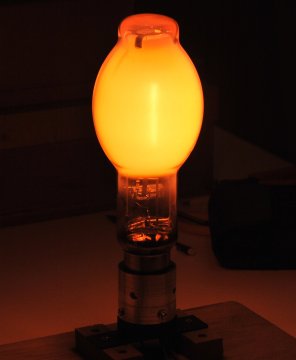
Look at the left hand pic here and compare it to the righthand pic above of the mercury arctube lit- both these pictures are taken from the same angle and you can see the position of the HPS arctube relative to the mercury- it is to the right of it. As above, the LH pic is during the warmup phase of this side of the lamp.
Check the start of this video- you see the glowbottle starter operate, then the HPS arctube is kicked into life. This is colour corrected HPS, the colour during warmup is purplish, turning the characteristic HPS golden colour as the vapour pressure in the arctube rises.
